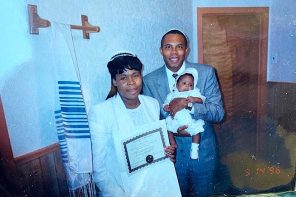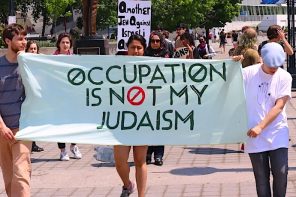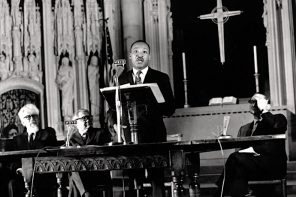What inspired you to write Suffer the Little Children?
When I was in graduate school, my (future) husband and I received a gag gift for Hanukkah. It was a two-foot-tall plush Judah Maccabee doll. The box said he was a “NOW a Huggable Hanukkah Hero.” He smiled, but he also had a shiny silver sword and shield.
I had just finished reading all four books of the Maccabees in a class on ancient Jewish history. The contrast between those bloody tales and our “huggable hero” stopped me in my tracks. It’s common, of course, to sanitize or glorify the past in our retellings (and even those ancient books are themselves retellings), but something about a huggable religious zealot really captured my imagination. All I wanted to think about was how we mediate the past for children—and how we tell stories about children who lived in the past. Writing about religion, memory, and children’s literature became my way of doing that.
What’s the most important take-home message for readers?
From 1945 to the present, Jewish and African Americans were grafted into greater American civic acceptance through their children’s stories—especially those stories with overtones of suffering, exodus, and sacrifice—in modes that have long been part of the grand narratives of American religious history.
I don’t say that to degrade those narratives or to promote them—but to notice how they are always with us, and how memory work is a practice, and a very complicated one. In the case of Jews, African Americans, and the overlaps across those identities, we can look at memory in a productive sense, at how pains touch one another, rather than devolving into the rhetoric of comparative suffering.
Is there anything you had to leave out?
Mormons. When I started this work, it involved a three-way comparison among Jews, African Americans, and Latter-day Saints. But there were also crucial figures—like Emmett Till—who needed a place in this book, and I found myself struggling to make space as the project moved along. So the Mormons went away. There is a lot that I have to say about them, in time. I did still include the book Meghan’s Secret, which is a short tale about an LDS girl reading The Diary of Anne Frank and over-identifying with her.
Had I but world enough and time, the book could have taken a slightly different journey and included a huge swath of twentieth-century children’s literature, particularly classics like Little House on the Prairie, which truly needs more analysis from the vantage point of religious studies. Perhaps that will be a different book.
What are some of the biggest misconceptions about your topic?
When I tell people about my book, they expect it to be prescriptive: a tome in which I tell people what to read to children, or what not to read to them. While I do think that the folks who read books with young people will find inspiration here, that wasn’t my goal. Rather, I want us to understand what we do with our stories, not whether they are “good” or “bad.”
That said, when my daughter is older, I will want her to read some of the books I’ve discussed, particularly All-of-a-Kind Family, The Keeping Quilt, A Wreath for Emmett Till, The People Could Fly, and everything that Maurice Sendak ever wrote or illustrated (though he hated being called an “illustrator”).
A big misconception about putting together the terms “religion” and “children’s literature” is that those two ideas are joined only in institutionally-driven works like children’s bibles or Sunday school tracts. Those are important, but the tropes we discuss in religious studies are very present in the children’s literature we think of as “secular.”
Also: the terms “Jewish” and “African American” are not mutually exclusive.
Did you have a specific audience in mind when writing?
I wrote it for religious studies scholars and literature scholars, in all of their varied, interdisciplinary incarnations. Although it is not a manual, I also wrote it with non-academics in mind. I want us all to be more reflective about how we “do” history and religion in quotidian contexts.
Are you hoping to just entertain readers? Inform them? Piss them off?
I’m primarily hoping to inform them. My writing is occasionally cheeky so I do hope to entertain; in the conclusion I express a flip longing for a “fairy godmother” of American religious studies. I think she would wear a funny colonial hat and spin Jonathan Edwards’ dangling spider—the one about to fall into the flames—from her magic wand. But that takes us right back into the grand Protestant narrative of American religious history, no?
I’m normally a very jokey person, but I deal with some dark subjects here—lynching, the Holocaust, the Middle Passage, wars—so it was hard to make any jokes. It’s the perfect book to read before bedtime.
What alternative title would you give the book?
Bound by Books: Sacrifice and Memory in Jewish and African American Children’s Literature. As you can tell, I’m bad at titles. I owe mine to a fine historian who shall remain unnamed in case anyone doesn’t like it. In that case, it is not his fault. And also, of course, I owe a certain debt to the authors of the New Testament.
How do you feel about the cover?
I adore the cover. The design team at NYU Press is brilliant. I love the dominant image of light spilling from a dark book and the vivid block of red below it. My favorite part is the font used for the word “Suffer.” The “F”s jump out like daggers—or stakes. I can pretend that Buffy would use my “F”s to slay a vampire.
Is there a book you wish you had written? Why?
This will sound shameless because she’s a senior correspondent for RD, but I have to be honest: Joanna Brooks’ The Book of Mormon Girl: A Memoir of an American Faith. It’s a memoir, so by definition only she could have written it, but it’s one of those books where I had to put it down, sit for a moment, and remember where I was when I had finished reading it. She really combines the thoughtfulness of a scholarly mind with the rawness of a personal voice. There are images in the book—the chevron-striped afghan that her father bought to save it from rejection, the dancers at the Rose Bowl, everything about Pioneer Day—that I can’t get out of my head. In my book, I can hide behind my footnotes and close readings, though my own experience does pop in once or twice. In a memoir you can’t do that.
It’s so hard to mention only one book. I also wish I had written Timothy Beal’s Religion and Its Monsters and Kathryn Lofton’s O: The Gospel of an Icon. They’re both examples of the sharp interdisciplinarity that made me want to be a religious studies scholar, with gorgeous prose besides.
What’s your next book?
My next big project will focus on how crafts, blogging, and the DIY movement more broadly intersect with religious practice and, especially, with women’s spiritual experience. From the Shawl Ministry, to the ways that women narrate their lives in virtual and material scrapbooks, to popular manuals on crafting and spirituality, this is a huge area for thinking about religion as it weaves (pardon the pun) back and forth between institutional or tradition-based settings and informal or unaffiliated spaces (aka the worlds of the much-discussed, somewhat misnamed “religious nones”).
It’s also a complex world of meetings across traditions, political affiliations, and, in the case of blogs, across regions. This is in its very early stages so it lacks a title and a publisher (hello, friendly acquisitions editors! 🙂 ). But I really hope that it involves a pun.




